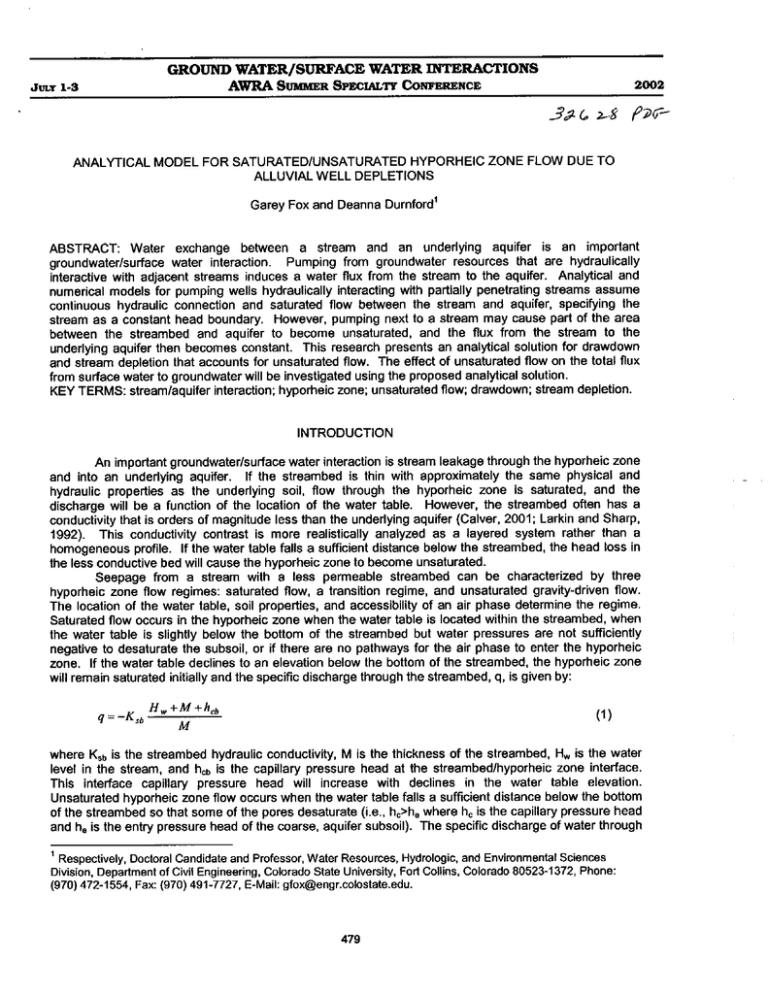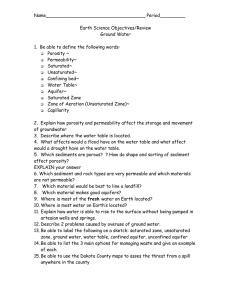Analytical Model For Saturated/Unsaturated
advertisement

J a y 1-3 GROUND WATER/SURFACE WATER INTERACTIONS AWRASUMMER SPECIALTY COIWEXENCE 2002 3 a ~g~ f2G- ANALYTICAL MODEL FOR SATURATEDlUNSATURATEDHYPORHEIC ZONE FLOW DUE TO ALLUVIAL WELL DEPLETIONS Garey Fox and Deanna Durnford’ ABSTRACT: Water exchange between a stream and an underlying aquifer is an important groundwater/surface water interaction. Pumping from groundwater resources that are hydraulically interactive with adjacent streams induces a water flux from the stream to the aquifer. Analytical and numerical models for pumping wells hydraulically interacting with partially penetrating streams assume continuous hydraulic connection and saturated flow between the stream and aquifer, specifying the stream as a constant head boundary. However, pumping next to a stream may cause part of the area between the streambed and aquifer to become unsaturated, and the flux from the stream to the underlying aquifer then becomes constant. This research presents an analytical solution for drawdown and stream depletion that accounts for unsaturated flow. The effect of unsaturated flow on the total flux from surface water to groundwater will be investigated using the proposed analytical solution. KEY TERMS: stream/aquifer interaction; hyporheic zone; unsaturated flow; drawdown; stream depletion. INTRODUCTION An important groundwater/surface water interaction is stream leakage through the hyporheic zone and into an underlying aquifer. If the streambed is thin with approximately the same physical and hydraulic properties as the underlying soil, flow through the hyporheic zone is saturated, and the discharge will be a function of the location of the water table. However, the streambed often has a conductivity that is orders of magnitude less than the underlying aquifer (Caber, 2001; Larkin and Sharp, 1992). This conductivity contrast is more realistically analyzed as a layered system rather than a homogeneous profile. If the water table falls a sufficient distance below the streambed, the head loss in the less conductive bed will cause the hyporheic zone to become unsaturated. Seepage from a stream with a less permeable streambed can be characterized by three hyporheic zone flow regimes: saturated flow, a transition regime, and unsaturated gravity-driven flow. The location of the water table, soil properties, and accessibility of an air phase determine the regime. Saturated flow occurs in the hyporheic zone when the water table is located within the streambed, when the water table is slightly below the bottom of the streambed but water pressures are not sufficiently negative to desaturate the subsoil, or if there are no pathways for the air phase to enter the hyporheic zone. If the water table declines to an elevation below the bottom of the streambed, the hyporheic zone will remain saturated initially and the specific discharge through the streambed, q, is given by: (1) where Kgbis the streambed hydraulic conductivity, M is the thickness of the streambed, H, is the water level in the stream, and hcbis the capillary pressure head at the streambedlhyporheic zone interface. This interface capillary pressure head will increase with declines in the water table elevation. Unsaturated hyporheic zone flow occurs when the water table falls a sufficient distance below the bottom of the streambed so that some of the pores desaturate (Le.. h,>h. where h, is the capillary pressure head and he is the entry pressure head of the coarse, aquifer subsoil). The specific discharge of water through 1 Respectively, Doctoral Candidate and Professor,Water Resources, Hydrologic. and EnvironmentalSciences Division, Department of Civil Engineering. Colorado State University, Forl Collins, Colorado 80523-1372.Phone: (970)472-1554,Fax: (970)491-7727.E-Mail: gfox@engr.colostale.edu. 479 the streambed is given by equation (I), where h,ph.. By continuity of mass, the discharge through the streambed is equivalent to the discharge through the unsaturated hyporheic zone, which is given by: where K(h,) is a constitutive relation between hydraulic conductivity and capillary pressure. Among the most popular of these constitutive relations are the Brooks-Corey (1964) and van Genuchten (1980) equations. The Brooks-Corey equations are K(h,)=K,, h,<fi, K(h,)=K, (aT 2 , h, >fie (3) where K, is the saturated hydraulic conductivity, he is the entry capillary pressure head, and q is a parameter dependent on the pore-size distribution index. The water table may eventually fall a sufficient distance below the streambed to develop a unit hydraulic gradient in the hyporheic zone; Le., ahJaZ=O in equation (2). The specific discharge through the streambed after formation of a unit hydraulic gradient, qWx.is given by: and the discharge through the hyporheic zone, using the Brooks-Corey constitutive relation, is: where h , is the interface capillary pressure head at the formation of a unit hydraulic gradient (Figure 1). Stream Streambed Hyporheic Zone . I Aquifei h= ,O Figure 1. Capillary pressure head (h,) distribution ( ) in the hyporheic zone after formation of a unit hydraulic gradient. h,,=interface capillary pressure head, H,=river stage, %,=drawdown, and M=streambed thickness. The transition from saturated flow to gravity-driven, unsaturated hyporheic zone flow is rapid, such that the transition regime can be ignored in analyzing streamlaquifer interaction. The capillary pressure head at the interface between the streambed and hyporheic zone, hcb,increases with increasing drawdown during saturated flow and the transition regime, and then reaches a constant, maximum capillary pressure head, ,,h with gravity-driven unsaturated flow (Figure 2). Once h., is reached, the capillary pressure head does not increase with declines in the water table. Therefore, stream leakage 480 vanes with water table position during saturated flow. A constant maximum leakage rate, , ,q is obtained when a unit hydraulic gradient occurs in the hyporheic zone beneath the streambed and the stream leakage does not change with any additional decline in water table position. 2.0 A h ~ j h , ....... :. B ~ C ~. : 1.5 0.0 0.3 0.2 0.1 0.5 0.4 (%-Hw-W'%, Figure 2. Interface capillary pressure head, hcb, divided by the entry pressure head of the aquifer, he,as a function of water table position, where &=drawdown, H,=water level in the stream, and M=streambed thickness, for hyporheic zone flow regimes: A (saturated flow), B (transition), and C (unsaturated flow). ANALYTICAL MODELS FOR ALLUVIAL WELL DEPLETIONS A pumping well located adjacent to a partially penetrating stream will intercept groundwater, reducing groundwater recharge to the stream and/or extracting water directly from the stream. While this problem has been analyzed extensively for decades (Hunt, 1999; Hantush. 1965; Theis, 1941), it is always assumed that the stream is a constant head boundary and flow between the stream and aquifer is saturated. Unsaturated flow is important because it transforms streams from constant head boundaries, where the discharge from the stream is dependent on the drawdown in the aquifer, to constant flux boundaries, where the discharge is independent of the position of the water table. Hunt's (1999) Solution for Saturated Flow Hunt (1999) developed analytical solutions for drawdown and stream depletion from a partially penetrating stream with a semipervious streambed. Hunt derived an equation for drawdown, &(x.y,t), in terms of the Theis (1935) well function, E,: + +IxI + 2 T ~ 9 l A ) ~y2 (L- x ) 2 + y 4zT 4Tt / S 4Tt I S 0 ]wi where x and y are horizontal coordinates with respect to a datum at the center of the river on a perpendicular line with the well, t is the time since the start of pumping, T is the transmissivity, S is the storage coefficient, Q is a constant well discharge rate, L is the distance between the pumping well and the center of the stream, 5 is the distance between the observation well and a particular location at the 401 stream, and h is a streambed conductance coefficient. Hunt (1999) also derived an equation for stream depletion, Qs. as a function of the pumping well discharge, Q: Hunt's (1999) solutions are limited to saturated flow between the stream and aquifer (Rushton, 1999). Proposed Solution for SaturatedlUnsaturatedFlow This paper linearly superimposes the drawdown contributions of flow from stream segments with unsaturated hyporheic zone flow and stream segments that remain saturated, as governed by the integral expression in equation (6). Superposition is appropriate since the governing partial differential equations are linear. The stream initially becomes perched nearest the well and then the length of stream undergoing unsaturated hyporheic zone flow increases over time as pumping continues. The proposed model accounts for segments of the stream closest to the pumping well becoming perched, while other contributing stream segments remain connected to the aquifer by saturated flow, as shown in Figure 3. Presently, the solution is limited to observation wells on a perpendicular line between the stream and pumping well (i.e.. y=O). 1 x Figure 3. Coordinate system for the proposed analytical model. yM is time-varying half-length of stream with unsaturated hyporheic zone flow. Let yhd be the time-varying half-length of stream with unsaturated hyporheic zone flow. The drawdown contribution due to recharge from the stream segment with unsaturated hyporheic zone flow can be quantified as: where W is the stream width, 1 is the variable of integration relating to the length along the stream segment with unsaturated hyporheic zone flow, and t, is the representative time at which unsaturated flow initiates along the stream length with unsaturated hyporheic zone flow. The time at which unsaturated flow begins at a particular stream location within yM varies. A weighted average is used to derive a representative time period, t-t,, for which unsaturated hyporheic zone flow occurs. Linear superposition results in an equation for aquifer drawdown resulting from pumping at a discharge rate, 0, when the stream has both saturated and unsaturated hyporheic zone flow: 482 8'= (J- -)1.1 2T The integral expression in equation (IO) is modified from Hunt (1999) by integrating only along the stream reach that remains connected to the aquifer through saturated flow. The first term on the right-hand side of equation ( I O ) is equivalent to the Theis (1935) equation. The second and third terms are the drawdown contributions due to recharge from stream segments with hyporheic zones undergoing saturated flow and unsaturated flow, respectively. The unsaturated hyporheic zone contribution to stream depletion is also linearly superimposed A stream depletion equation for with segments hydraulically connected by saturated flow. saturatedlunsaturated hyporheic zone flow is derived based on the difference between the streamflow contribution from the unsaturated hyporheic zone flow stream segment under saturated versus from the unsaturated hyporheic zone flow. During saturated flow, the stream contribution (a,) unsaturated hyporheic zone flow stream segment is dependent on drawdown and is given by: (12) Q U T = 2hs,Yhd where h is a streambed conductance coefficient and s, is a representative drawdown along the unsaturated hyporheic zone flow stream length assuming saturated flow. More specifically, sris the weighted average of drawdown along the unsaturated hyporheic zone flow stream segment that would have occurred if this stream segment had remained saturated. The contribution during unsaturated hyporheic zone flow (QNSAT) is The ratio of stream depletion to pumping well discharge rate can then be expressed as where the first term on the right hand side is given by Hunt (1999) for the stream depletion from an infinite stream length assuming saturated hyporheic zone flow. Figure 4 compares the predicted2imensionlessdrawdown (sT/Q) and stream depletion (QJQ) as a function of dimensionless time (tT/SL ) between the proposed analytical solution and Hunt's (1999) solution. This example assumes a coarse, sand aquifer overlaying a silt streambed with KSb=0.50m-d-', W=5.0 m, M=0.5 m, H,=0.5 m, h.=0.05 m, q=8, and an observation well at x/L=O.lO and y/L=O.O. Unsaturated hyporheic zone flow limits the amount of water available from the stream to satisfy aquifer stress, increasing the predicted drawdown in the aquifer. Unsaturated hyporheic zone flow in response to a pumping well results in a larger contributing stream length when compared to a solution that assumes the streadaquifer connection remains saturated. As the stream becomes perched, stream discharge in the perched length becomes limited to the maximum specific discharge,.,,q, Because the well cannot draw more water from the stream in the nearest reach, it draws more water from aquifer storage, corresponding to larger drawdown compared to the saturated flow case where specific discharge is not limiting. As drawdown in the aquifer increases, the radius of influence increases. Thus, a limited constant 483 specific discharge in the perched reach results in more of the stream contributing to well discharge compared to the saturated case. If only a finite stream reach is available to meet the pumped well discharge requirements, the length of stream with an unsaturated hyporheic zone will increase until the entire finite stream is perched. At that time, stream depletion would reach a limit and additional well discharge would need to be provided by release of aquifer storage only. 0.4 , 1 1.0 0 5 s 0.3 $m b 0.2 I 6 'E -0~. Proposed Solution 0.1 - SrIQ Hunt(1999)-QslQ 6 0.0 0 100 200 300 400 DimensionlessTime, tTlSL2 Figure 4. Comparison of predicted drawdown and stream depletion between the saturatedlunsaturated hyporheic zone solution and Hunt's (1999) solution for an observation well at xlL=O.l and y/L=O. ACKNOWLEDGMENTS The authors acknowledge the financial support of the USDA National Needs Fellowship Program, Grant No. 00-38420-8825, and the assistance of Bill Sanford, Jorge Ramirez. and Luis Garcia. REFERENCES Brooks R.H. and A.T. Corey, 1964. Hydraulic properties of porous media. Colorado State University Hydrology Paper No. 3, March, 27 p. Calver A,, 2001. Riverbed permeabilities: Information from pooled data. Ground Water 39(4): 546-553. Hantush M.S., 1965. Wells near streams with semipervious beds. Journal Geophysical Research 70(12): 2829-2838. Hunt B., 1999. Unsteady stream depletion from ground water pumping. Ground Water 37(1): 98-102. Larkin R.G., and J.M. Sharp, 1992. On the relationship between river-basin geomorphology, aquifer hydraulics, and ground-water flow direction in alluvial aquifers. Geological Society of America Bulletin 104: 1608-1620. Rushton K.. 1999. Discussion of "Unsteady stream depletion from ground water pumping" by B. Hunt. Ground Water 37(6): 805. Theis C.V., 1941. The effect of a well on the flow of a nearby stream. American Geophysical Union Transactions 22(3): 734-738. Theis C.V., 1935. The relationship between the lowering of the piezometric surface and the rate and duration of discharge from a well using ground-water storage. Transactions of the American Geophysical Union 2: 519-524. van Genuchten M.T.. 1980. A closed-form equation for predicting the hydraulic conductivity of unsaturated soil. Soil Science Society of America Journal 44: 892-898. 484


